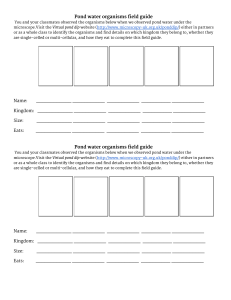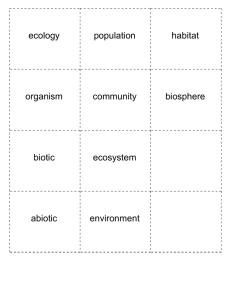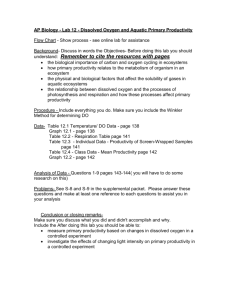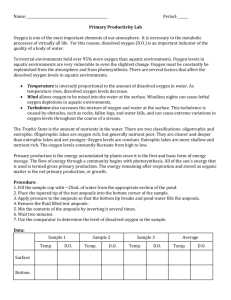File
advertisement
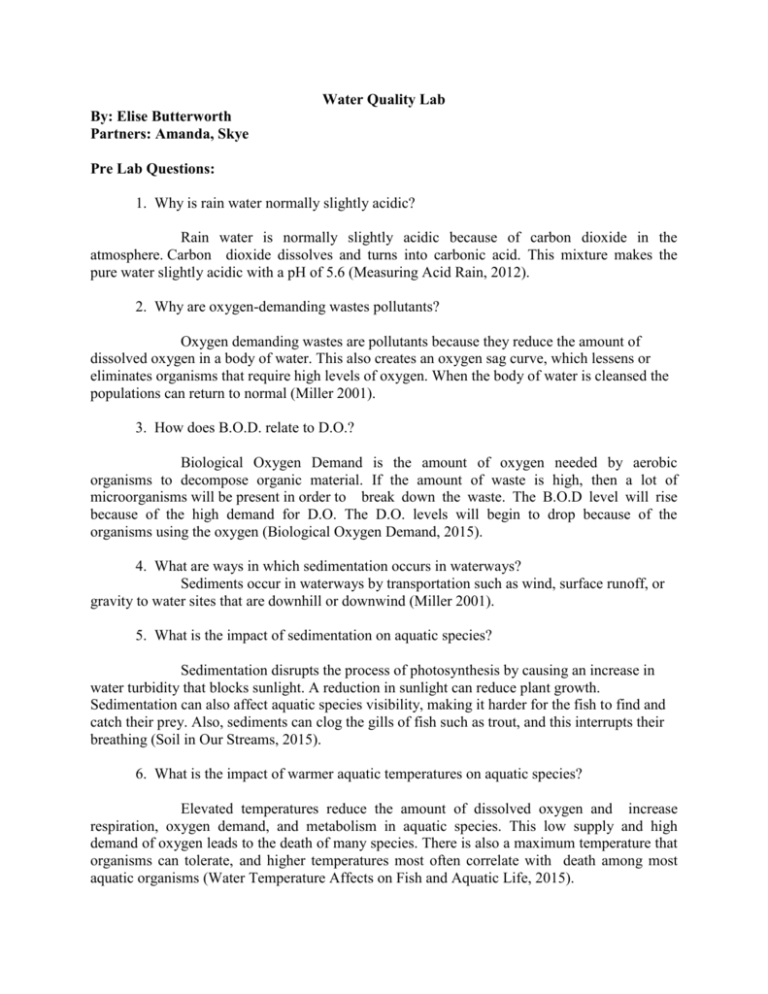
Water Quality Lab By: Elise Butterworth Partners: Amanda, Skye Pre Lab Questions: 1. Why is rain water normally slightly acidic? Rain water is normally slightly acidic because of carbon dioxide in the atmosphere. Carbon dioxide dissolves and turns into carbonic acid. This mixture makes the pure water slightly acidic with a pH of 5.6 (Measuring Acid Rain, 2012). 2. Why are oxygen-demanding wastes pollutants? Oxygen demanding wastes are pollutants because they reduce the amount of dissolved oxygen in a body of water. This also creates an oxygen sag curve, which lessens or eliminates organisms that require high levels of oxygen. When the body of water is cleansed the populations can return to normal (Miller 2001). 3. How does B.O.D. relate to D.O.? Biological Oxygen Demand is the amount of oxygen needed by aerobic organisms to decompose organic material. If the amount of waste is high, then a lot of microorganisms will be present in order to break down the waste. The B.O.D level will rise because of the high demand for D.O. The D.O. levels will begin to drop because of the organisms using the oxygen (Biological Oxygen Demand, 2015). 4. What are ways in which sedimentation occurs in waterways? Sediments occur in waterways by transportation such as wind, surface runoff, or gravity to water sites that are downhill or downwind (Miller 2001). 5. What is the impact of sedimentation on aquatic species? Sedimentation disrupts the process of photosynthesis by causing an increase in water turbidity that blocks sunlight. A reduction in sunlight can reduce plant growth. Sedimentation can also affect aquatic species visibility, making it harder for the fish to find and catch their prey. Also, sediments can clog the gills of fish such as trout, and this interrupts their breathing (Soil in Our Streams, 2015). 6. What is the impact of warmer aquatic temperatures on aquatic species? Elevated temperatures reduce the amount of dissolved oxygen and increase respiration, oxygen demand, and metabolism in aquatic species. This low supply and high demand of oxygen leads to the death of many species. There is also a maximum temperature that organisms can tolerate, and higher temperatures most often correlate with death among most aquatic organisms (Water Temperature Affects on Fish and Aquatic Life, 2015). Data Table: WEIGHING FACTOR: .10 TOTAL: 0 mg/L Q-VALUE /QUALITY: 98 Phosphates (PO4 ) 1 mg/L 40 .10 4 D.O. 3 mg/L D.O. 25 % Saturation 13 .17 2.21 5 30 .11 3.3 0 oC 150 mg/L 93 80 .10 .07 9.3 5.6 40 NTU 23 .08 1.84 72 .11 7.92 positive .16 TEST TEST RESULTS: Nitrates (NO3-) 3- pH Iron .02 ppm Copper 0 ppm Hardness 0 ppm Alkalinity 20 ppm Temperature #1 10 oC Temperature #2 10 oC ΔoC TDS TSS (Turbidity) B.O.D. B.O.D. Macroinvertebrates Macroinvertebrates Macroinvertebrates Fecal Coliform 9.8 .4 mg/L Dark D.O. 2.6 Δ mg/L D.O. 1 # Intolerant (Group 1) 1 # Moderate (Group 2) 2 # Tolerant (Group 3) colonies/100 mL Water Quality Index (WQI) = 43.97 x 1.19 = 52.32 or Average Water Quality Cumulative Index Value = 7 , Poor Pond Quality 1x3=3 1x2=2 2x1=2 POST-LAB QUESTIONS: 1. Based on the WQI value for our Eco-Studies Pond, what would be its Water Quality Rating? Explain your overall pond assessment as it relates to WQI. The ponds water quality rating would be average. This is because the pH level was adequate. Although, the dissolved oxygen levels were fairly low so this would decrease the quality of the water because of a loss of species. In addition, turbidity levels were moderate, and concentrations of phosphates and nitrates were not too high. 2. Of all of the tests performed, which should have the greatest impact on the Water Quality Rating? Explain why. Dissolved oxygen would have the greatest impact on the WQR because without oxygen in the pond, aerobic species would not be able to survive. 3. If our Eco-Studies Pond showed high NO3ˉ levels, what might be the source? High levels of nitrates could come from fertilizer runoff that is coming from grass surrounding the pond. Also, nitrates may enter the pond by animal waste. 4. What might be the cause of high turbidity? Explain your answer. High turbidity could be caused by soil erosion that creates a buildup of sediment in the water. Some examples of sediments are soil and silt. Another cause of high turbidity could be excess growth of algae from nitrates and phosphates that enter the water. Lastly, organic and inorganic material could cause cloudiness in the water. 5. What might be two causes of a higher temperature in the different sides of the pond? Both sides of the pond had a temperature of 10 degrees Celsius. Although, difference in water quality could come from shading on one side of the pond. For example, mod one could potentially block sunlight from side of the pond closest to it. Also, sediment eroding from the slight hill on the side of the pond farthest away from the mods, could cause turbidity. This would block sunlight and lower water temperatures on that side. 6. What problem might result from a higher pond temperature? A higher pond temperature decreases levels of dissolved oxygen, which causes an increase in biological oxygen demand. This deficit of supply can instigate the death of many organisms. 7. We did not test for fecal coliform bacteria. Why might this test not be necessary for our Eco-Studies Pond? Fecal Coliform bacteria may not be necessary to test because it is known that the many organisms living in the pond produce fecal matter. So in effect, fecal coliform bacteria should be present in moderate amounts. 8. Discuss the importance of the “other chemical” tests and what information can be learned from each. Hardness in water measures the concentrations of divalent salts and alkalinity measures base concentrations. Alkalinity testing is important because in ponds with low alkalinity levels, certain nutrients are unavailable to aquatic plant life. Information such as how stable the environment is can be learned by alkalinity levels because these bases neutralize acids, buffering pH levels. Hardness testing is also important because hard water has a higher concentration of alkaline earths. Again, information about pH can be learned through hardness tests. Also, testing copper levels is important because copper can be toxic to aquatic organisms. From the test, dissolved oxygen levels can be estimated because high levels of copper can kill algae, which depletes dissolved oxygen ` levels. Testing for iron is also important because it plays a factor in organism health. Low levels of iron decrease metabolism rates in some aquatic species (Water Temperature Effects on Fish and Aquatic Life, 2015). 9. Explain how indicator species are used to assess water quality and explain why they are a good measure for determining water quality. (Hint: Compare your cumulative index value with your water quality index.) The presence or absence of indicator species can aid in determining water quality. For example, the presence of trout can indicate high levels of dissolved oxygen and clean water. Also, bottom dwelling species can be used to assess water quality because the water is filtered through their bodies. If the water is polluted than the organisms will show signs of this. Lastly, indicator species such as cattails, can be removed from their environment and analyzed to determine the exact pollutants contained in a body of water. Indicator species are a good measure for water quality because they provide early warning signs of damage to an ecosystem. The cumulative index value and water quality index value were somewhat similar, so indicator species can provide around the same results as water quality tests (Miller, 2001). Citations: Measuring Acid Rain. (n.d.). Retrieved December 4, 2015, from http://www3.epa.gov/acidrain/measure/index.html Miller, T. (2001). Living in the environment: Concepts, problems, and alternatives. Belmont, Calif.: Wadsworth Pub Biological Oxygen Demand. (n.d.). Retrieved December 4, 2015, from http://www.polyseed.com/misc/BODforwebsite.pdf (n.d.). Retrieved December 4, 2015, from http://www.bae.ncsu.edu/programs/extension/wqg/sri/sediment5.pdf Water Temperature Effects on Fish and Aquatic Life. (n.d.). Retrieved December 5, 2015, from http://sciencefairwater.com/physical-water-quality-parameters/water-temperature/watertemperature-effects-on-fish-and-aquatic-life/ Water Quality Concerns for Ponds (Water Quality). (n.d.). Retrieved December 11, 2015, from http://extension.psu.edu/natural-resources/water/ponds/pond-management/pondconstruction/water-quality-concerns-for-ponds


